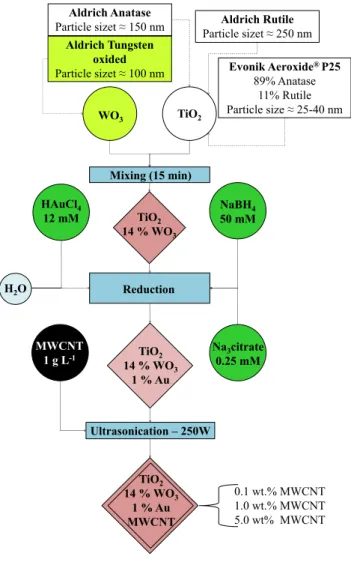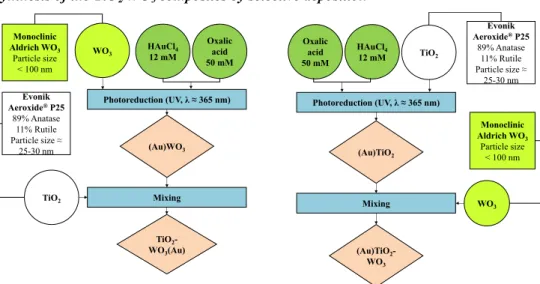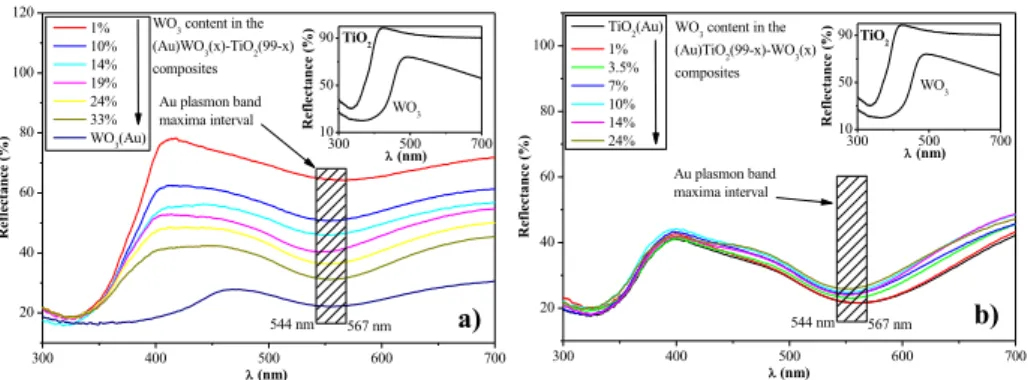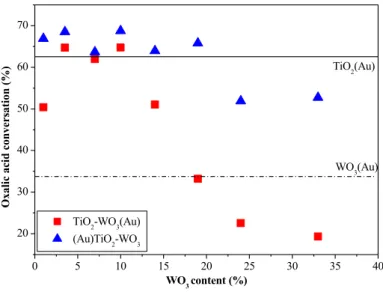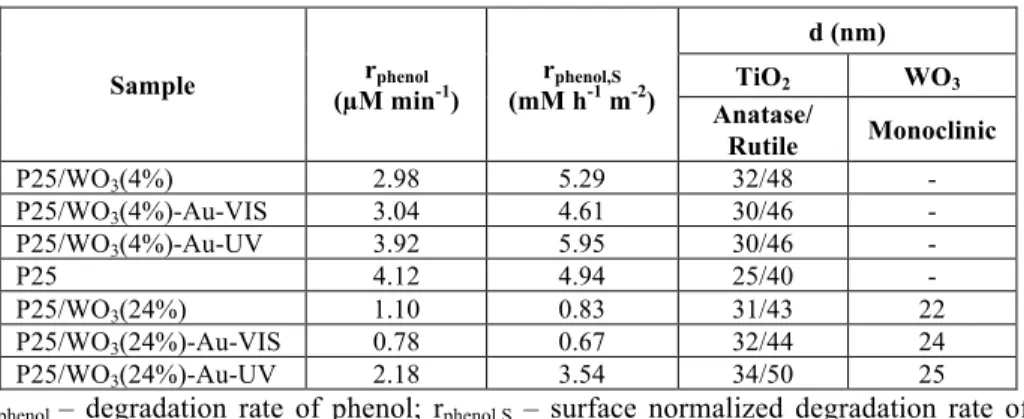The synthesis of TiO
2/WO
3composite photocatalysts - the role of the WO
3in the charge trapping process
Karácsonyi Éva Doctoral (Ph.D.) thesis
Supervisor:
Dr. Pap Zsolt
Doctoral School of Environmental Sciences
University of Szeged
Institute of Environmental Science and Technology
Szeged
2017
- 1 - Introduction
Nowadays, environmental issues are increasingly highlighted and studied worldwide. Numerous publications, forums, conferences deal with these environmental issues concerning the pedosphere, the atmosphere and hydrosphere.
One of the main problems are water resources, which are constantly decreasing and deteriorating in quantity and quality.The Environmental Chemistry Research Group from the University of Szeged is working on the development of innovative water purification technologies, which are implemented through the advanced oxidation processes. One of these processes is heterogeneous photocatalysis, in which the photocatalyst generates electron-hole (e- and h+) pairs on its surface. The photogenerated charge carrier pairs can participate in redox reactions, although their recombination is a favored process.
Titanium dioxide (TiO2) is one of the most widely used photocatalysts in the UV range [1-3]. The studied materials, the photocatalysts were used in many interesting and useful applications such as: organic pollutant degradation, like phenol [4], oxalic acid [5-6]; exploitation of the solar energy [7], like dye–sensitized solar cells [8], photocatalytic H2 production [9-11], etc. Besides titania photocatalysts, there are other semiconductors which are applied in photocatalysis, for example WO3 or ZnO. The main advantage of tungsten oxide is the high stability and lower band-gap energy. The latter means that the photocatalysts can absorb the sunlight more efficiently (from visible to UV). Taking advantage of the above listed properties, WO3 can be applied as a photoelectrocatalyst. During the preparation of TiO2/WO3 composite photocatalysts, we focused on achieving efficient electron-hole separation and delayed recombination of charges.
- 2 - Objectives of the present PhD. thesis
The main objective is to obtain and to characterize TiO2/WO3 composite photocatalysts, while focusing on the charge separation properties of WO3. The composites will be obtained using commercial TiO2 (Evonik Aeroxide P25, Aldrich anatase and rutile), while different synthesis approaches will be also investigated, such as ultrasonic and physical mixing, chemical reduction (noble metals) and impregnation. These methods would give information concerning the role of the WO3 component (crystal geometry, morphology, crystal structure, etc.). Other charge separators will be applied to enhance further the photoactivity of the composites.
In the case of the composites obtained by ultrasonic homogenization it will be investigated, that:
• the presence of additional composite components, such as MWCNT can influence the activity of the material,
• if yes, what is the impact if its concentration in the composite
When selective photoreduction was applied to obtain TiO2/WO3 /noble metal ternary composites, it will be investigated:
• the importance of the noble metal nanoparticles’ localization on a specific oxide,
• the impact of the WO3 content on the photoactivity of the composites
The impregnation approach will be investigated as alternative approach in obtaining WO3 forms, influencing positively the activity, when:
• the WO3 content dependence will be investigated of the different WO3 forms and their general impact on the photoactivity of the composites.
• is the photoreduction of noble metals by different light sources important?
In case of simple physical mixing of the components, the following important parameters will be investigated which may have major importance in defining the photoactivity of the composites: crystal structure and morphology trough shape tailoring approaches
- 3 - Synthesis of the TiO2/WO3 composites
Synthesis of the TiO2/WO3 composites by reduction and ultrasonication
Evonik Aeroxide® P25 89% Anatase
11% Rutile Particle size≈ 25-40 nm Aldrich Rutile Particle sizet≈ 250 nm
Ultrasonication – 250W Reduction Mixing (15 min) Aldrich Tungsten
oxided Particle sizet≈ 100 nm
HAuCl4
12 mM TiO2
14 % WO3
WO3 TiO2
NaBH4 50 mM
H2O
TiO2 14 % WO3
1 % Au
Na3citrate 0.25 mM MWCNT
1 g L-1
TiO2 14 % WO3
1 % Au MWCNT Aldrich Anatase Particle sizet≈ 150 nm
0.1 wt.% MWCNT 1.0 wt.% MWCNT 5.0 wt% MWCNT
Figure 1. Synthesis of the TiO2/WO3/Au/MWCNT composites
- 4 -
Synthesis of the TiO2/WO3 composites by selective deposition
(Au)TiO2- WO3
Photoreduction (UV, λ ≈365 nm) TiO2 HAuCl4 12 mM Oxalic
acid 50 mM
(Au)TiO2
Mixing WO3
Monoclinic Aldrich WO3
Particle size
< 100 nm Evonik Aeroxide®P25
89% Anatase 11% Rutile Particle size≈
25-30 nm Photoreduction (UV, λ ≈365 nm)
TiO2
HAuCl4 12 mM
Oxalic acid 50 mM
(Au)WO3
TiO2- WO3(Au)
Mixing WO3
Monoclinic Aldrich WO3
Particle size
< 100 nm
Evonik Aeroxide®P25
89% Anatase 11% Rutile Particle size≈
25-30 nm
Figure 2. Synthesis of the TiO2/WO3 composites by selective photodeposition
Synthesis of the TiO2/WO3 composites by impregnation
All chemicals used in synthesis of the composites were of analytical grade (from Sigma-Aldrich) and were used without further purification. 0.78 g (or 0.13 g in the case of the catalysts with 4 wt. % WO3) of H2WO4 (as WO3 precursor) was added to 150 mL 6.6 wt.% NH3 aqueous solution, under stirring at room temperature. A specific amount (2.27 g – 4 wt.% WO3 containing composites, 2.88 g – in the case of 24 wt.% WO3 containing composites) of TiO2 (Evonik Aeroxide P25) was transferred in the obtained solution with continuous stirring at 60 ºC for 30 min. The obtained composite was dried in an oven at 80 °C for 24 hours and calcined at 700 ºC in a muffle furnace (heating rate 4 ºC/min), for 2 hours in still-air.
The gold deposition: the gold was performed under UV light (6 × 6 W Black Light Lamps, with λmax ≈ 365 nm) using 12 mM HAuCl4 solution as gold precursor
- 5 -
and 50 mM oxalic acid as hole scavenger, in a thermostated 200 mL Pyrex reactor (filled with 175 mL suspension). The P25/WO3 catalyst concentration was 1 g/L, while the gold precursor quantity was calculated to have an equivalent of 1 wt. % Au on the suspended composite. The reduction process was performed for 4 hours. The visible light deposition followed the procedure detailed previously, the only difference was that 6 × 6 W Philips fluorescent lamps (visible light emitting coating) were used and 1M NaNO2 was circulated in the thermostating jacket to eliminate any UV radiations. All the composites were washed several times in deionized water and dried at 80 °C for 24 hours. Au content was proven to be ≈1 wt. % in all the composite materials and no traces of the precursor was detected using UV-Vis spectrophotometry.
Synthesis of the TiO2/WO3 composites using WO3 crystals obtained via hydrothermal crystallization
Synthesis of the WO3 crystals from AMT: WO3 microcrystals were synthesized by hydrothermal crystallization. 0.664 g AMT (ammonium metatungstate) was used. The precursor was dispersed in 88.48 mL 5 M HCl solution and were continuously stirred for 20 minutes. After that 10 mg of fMWCNTs (functionalized multiwalled carbon nanotubes) were added as a crystallization’s promoter (the fMWCNT content was constant in all the cases). This was followed by the addition of 1.52 mL of HF solution (40 v/v %). The mixture was poured into a 100 mL Teflon lined autoclave and maintained at 180 ºC for 1, 5 or 24 h. After it was left to cool down to room temperature, the product was washed (Eppendorf Centrifuge 5702;
centrifuging time: 5 min, rev: 4400 rpm) and dried at 40 ºC for 24 h. Synthesis of the WO3 crystals from STD: The process for the preparation of the WO3 crystals produced
- 6 -
from sodium tungstate is the same as for the production of WO3 from AMT, except that the STD precursor was 0.858 g.
Methods and instrumentation
The X-ray diffraction (XRD) of the patterns were recorded using Cu-Kα radiation (λ=1.5406 Å) equipped with a graphite monochromator. The measurements were performed on a Shimadzu 6000 diffractometer. The average size of the crystals was calculated using the Scherrer equation where it was possible.
JASCO-V650 spectrophotometer with an integration sphere (ILV-724) was used for measuring the DRS spectra of the samples (λ=300-800 nm).
SEM (Scanning Electronic Microscopy) micrographs were recorded using a Hitachi S-4700 Type II cold field emission scanning electron microscope equipped with a Röntec QX2-EDS spectrometer. Transmission electron microscopic (TEM) measurements were performed to characterize the crystallite size, distribution and to identify the morphology of the particles. TEM micrographs were recorded on a Philips CM 10 instrument operating at 100 kV using Formvar coated copper grids.
XPS measurements were performed on a SPECS PHOIBOS150 MCD instrument, with monochromatized Al K radiation (1486.69 eV) at 14 kV and 20 mA, and a pressure lower than10−9 mbar. Analysis of the obtained data was carried out with CasaXPS software.
The FT-Raman spectra were recorded by using a Bruker Equinox 55 spectrometer with an integrated FRA 106 Raman module using an Nd-YAG laser (1064 nm). Raman spectra were recorded with a spectral resolution of 1 cm-1.
The assessment of the photocatalytic efficiencies
The photocatalytic activity was determined by the photodegradation of (i) 0.5 mM phenol and (ii) 5 mM of oxalic acid solution (the concentration values were
- 7 -
chosen based on our long-term experience with these substrates. The concentration decrease of the chosen contaminant (phenol or oxalic acid) was followed using an Agilent 1100 series HPLC system. This consist of a binary pump; a micro vacuum degasser; a diode array detector (λdetection = (i) 210 nm (ii) 206 nm); a thermostated column compartment and ChemStation data managing software. The chromatographic system was equipped with Rheodyne Model 7725 injector with a 20 µL loop and a (i) Lichrosper PR 18 (ii) GROM-RESIN ZH column. The eluent consisted of (i) 8.8 M methanol aqueous solution (ii) 19.3 mM H2SO4 aqueous solution and the applied flow rate was 0.8 m · min-1 in all the cases.
Results and discussion. Key thesis points
Synthesis of the TiO2/WO3 composites by reduction and ultrasonication
T1: An appropriately low amount of MWCNT was favorable concerning the photocatalytic activity of the nanocomposites.
0 0,1 0,2 0,3 0,4 0,5 0,6
0 10 20 30 40 50 60 70 80 90 100 110 120
Hydrogen evolution rate (µmol/min)
Time (min) P25-ATO-Au
P25-ATO-Au-MWCNT (0.1%) P25-ATO-Au-MWCNT (1%) P25-ATO-Au-MWCNT (5%)
0.6 0.5 0.4 0.3 0.2 0.1
Hydrogenevolutionrate(µmol/min) 0.0
Figure 3. TiO2/WO3/Au/MWCNT composites hydrogen production rate
- 8 -
P25-based composites showed a remarkable hydrogen production capacity compared to the pure anatase and rutile containing materials with large nanoparticles.
The presence of MWCNT’s lowered somewhat the hydrogen production rate.
However, at low MWCNT concentration (0.1 wt.%) a small improvement was observed concerning the achieved maximum value of the hydrogen production rate (Figure 3), while at other MWCNT concentration values this enhancement was not observable (e.g. 0.1, 1.0 and 5.0 wt.%). The 0.1 wt.% value must be an optimum, as the photogenerated electrons can be captured either by WO3, Au or even MWCNT, pointing out an intensive competition, between the electron-separators.
Synthesis of the TiO2/WO3 composites by selective photodeposition
T2: The localization of the noble metal nanoparticles within the composite was crucial.
300 400 500 600 700
20 40 60 80 100 120
TiO2
WO3
567 nm Au plasmon band
maxima interval
Reflectance (%)
l (nm) 1%
10%
14%
19%
24%
33%
WO3(Au)
WO3 content in the (Au)WO3(x)-TiO2(99-x) composites
544 nm
300 500 700
10 50 90
Reflectance (%)
l (nm)
300 400 500 600 700
20 40 60 80 100
TiO2(Au) 1%
3.5%
7%
10%
14%
24%
WO3 content in the (Au)TiO2(99-x)-WO3(x) composites
Reflectance (%)
l (nm) Au plasmon band maxima interval
544 nm 567 nm WO3 TiO2
300 500 700
10 50 90
Reflectance (%)
l (nm)
a) b)
Figure 4. DRS spectra of sample series (a) (Au)WO3(x)–TiO2(99 − x) and (b) (Au)TiO2(99 − x)–WO3(x)
Considering the optical properties of the ternary composites, it was observed, that the reduction of gold on the surface of TiO2, within the ternary composite resulted
- 9 -
an optical independency (band-gap values) from the WO3 content (Figure 4b). This was not the case when the Au was deposited on the surface of WO3, namely that with the change of the WO3 content, the band-gap of the composite changed likewise (Figure 4a). This points out a possibility to finely tune the band-gap of composites, using this approach. The observed optical difference was also valid for Pt, but no clear order or any trends were noticed.
0 5 10 15 20 25 30 35 40
20 30 40 50 60 70
Oxalic acid conversation (%) TiO2(Au)
TiO2-WO3(Au) (Au)TiO2-WO3
WO3 content (%)
WO3(Au)
Figure 5. Photocatalytic performance of the sample series (Au)TiO2(99 − x%)–
WO3(x%) and (Au)WO3(x%)–TiO2(99 − x%)
T3: The photocatalytic activity of the nanocomposites was maximum when the WO3 concentration was around 10%.
With the increase of the tungsten (VI) oxide content the composites with noble metal deposited on TiO2 showed different behavior compared to the ones with Au or Pt deposited on WO3 (in the first case a roughly constant activity is observed,
- 10 -
which decreases at higher WO3 content, while in the latter case a bell-shaped curve is perceived with the maximum around 10 wt.% of WO3). In all the series, at least two catalysts were surpassing the activity of the reference catalysts TiO2(Au) and TiO2(Pt), whilst nearly all the materials were more active than WO3(Au) and WO3(Pt) references (Figure 5). If the WO3 content is raised above a critical level (24 wt.%) a severe activity decrease was observable in an of the studied cases, but the most spectacular decrease was observed, when the noble metals were deposited on the surface of WO3.
Synthesis of the TiO2/WO3 composites by impregnation
T4: By choosing the impregnation as the synthesis pathway for the P25/WO3
composites, resulted in a material which contained the three WO3 forms (amorphous, crystalline, doped) in different proportions, which influenced critically the resulting photoactivity.
The obtained nanocomposites were investigated using different characterization techniques. When the DRS spectra were recorded and analyzed it was found that doping must occur in the composites which contained 4 wt.% of WO3.
The Raman spectrum investigations pointed out, the previously mentioned aspect of doping, while specific signs of monoclinic WO3 (710 and 800 cm-1), and amorphous WO3 (260 cm-1 (O-W-O), 950-960 cm-1 (W=O) and 1126 cm-1) were registered, demonstrating the presence of both forms in the composites with just 4% of WO3. When the amorphous WO3 was present, it was found that the photoactivity was enhanced, compared to the samples which contained 24% of WO3. The surface normalized reaction rate values of the most performing samples even surpassed the activity of Evonik Aeroxide P25 (Table 1)
- 11 -
Table 1. UV photodegradation rates of phenol and crystallite sizes
Sample rphenol
(µM min-1) rphenol,S
(mM h-1 m-2)
d (nm)
TiO2 WO3
Anatase/
Rutile Monoclinic
P25/WO3(4%) 2.98 5.29 32/48 -
P25/WO3(4%)-Au-VIS 3.04 4.61 30/46 -
P25/WO3(4%)-Au-UV 3.92 5.95 30/46 -
P25 4.12 4.94 25/40 -
P25/WO3(24%) 1.10 0.83 31/43 22
P25/WO3(24%)-Au-VIS 0.78 0.67 32/44 24
P25/WO3(24%)-Au-UV 2.18 3.54 34/50 25
rphenol – degradation rate of phenol; rphenol,S – surface normalized degradation rate of phenol; d – crystallite size
250 450 650 850 1050 1250
P25-WO3(4%)-Au-VIS P25-WO3(24%)-Au-UV
P25-WO3(4%)-Au-UV
P25-WO3(24%)
P25-WO3(4%)
RA A × × ×
Raman Intensity
Wavenumber (cm-1)
× A
P25 9×
9×
Figure 6. Raman spectra of the investigated photocatalysts
- 12 -
Synthesis of the TiO2/WO3 composites using WO3 crystals obtained via hydrothermal crystallization
T5: The hydrothermal crystallization times affects the WO3 crystals’ size, morphology, crystal phase composition.
STD-36-1HF
STD-24-1HF
STD-5-1HF
STD-1-1HF
20 25 30 35 40
Intenzitás (ö.e.)
2 theta (fok)
STD-1-1HF STD-5-1HF STD-24-1HF STD-36-1HF
The time of th e cr ys ta liz at io n
STD-1-1HF STD-5-1HF STD-24-1HF STD-36-1HF
(120)
(111)
(031) (140) (120) (022)
(040) (200) (002) (131) (020)
(001) (120) (220) (121)(111)
(021)
(121)
(021) (201)(111) (220) (001)
(020) (120) (101) (111) (200)
(001) (020) (110) (311) (111)
(120) (400) (120)(200)(111)(021) (201)
2 µm 2 µm
2 µm
2 µm
c_WO3(H2O)0.5 o_WO3 t_H0.23WO3 o_WO3•H2O
Intensity
(degree)
Figure 7. The XRD patterns and the crystallization time’s influence on the WO3 (obtained from STD) crystals’ size
The crystal’ size of the obtained samples increased with the duration of the crystallization time, while crystal phase changes were observed as well (orthorhombic
- 13 -
WO3·H2O → orthorhombic WO3 → tetragonal H0.23WO3 and tetragonal WO3(H2O)0.5) (Figure 7). This proves, that by the simple adjustment of the crystallization time the crystal phase composition and chemical composition of the samples can be achieved successfully.
T6: The HF was responsible in the stabilization of certain crystallographic planes and thus for the geometry of the nanocrystals.
monoclinic WO3
0 HF 1 HF 2 HF
orthorombic H2O·WO3 WO3
precursor HF HF
1 µm 2 µm 500 nm
Figure 8. The effect of the concentration of the HF solution (crystallization time 1 h)
When HF was absent from the crystallization procedure, monoclinic WO3 was obtained with nm sized crystals. When HF was present the formation of hydrates was favored with specific crystal geometry. When the concentration of HF was further raised, the development of new crystallographic planes was observed, while stabilizing the already appeared ones (Figure 8). Therefore, it was successfully shown, that HF can act as a shape-tailoring agent, which favors specific geometry and crystal
phase composition.
- 14 - Summary
The main aim of the research with TiO2/WO3 photocatalyst composites was to study the charge trapping ability of the WO3 component in the composites. This was examined by changing the crystal structure and morphological properties of the WO3 component.
For the TiO2/WO3/Au/MWCNT composites, it has been found that carbon nanotubes added at a sufficiently low concentration could have a positive effect on the photocatalytic activity of the composite. However, we cannot ignore the fact that both Au, Pt and the carbon nanotubes, and even the WO3 component of the composite, can behave as electron acceptors, so they reduced rather than increased photocatalytic activity of the system.
After the successful selective photoreduction, the studies have shown that the localization of the noble metals within the TiO2/WO3 composites (on the surface of one of the oxides) was crucial. When the noble metal was located on TiO2, the light absorption properties of the composites does not change significantly by increasing the concentration of WO3 in TiO2/WO3/noble metal (Pt and Au) composites.
However, otherwise (when the noble metal was located on WO3) the light absorption properties were strongly dependent on the WO3 content of the composites, while the photocatalytic activity of the composite decreases by increasing the concentration of WO3 in TiO2/WO3/noble metal (Pt and Au) composites above a specific level (24 wt.%). It was found that the optimal WO3 concentration could be within 10 wt.% in the case of the TiO2/WO3/noble metal (Pt and Au) composites.
The TiO2/WO3/Au composites produced by impregnation contained a low (4 wt.%) amount of WO3, while tungsten was identified as a possible doping element.
Furthermore, at this WO3 content values both amorphous and crystalline WO3 was
- 15 -
identified. So maybe not the presence of the noble metal, but the amorphous nature of WO3 was beneficial on the photocatalytic activity of these composites.
Obtaining the WO3 by hydrothermal crystallization, the effect of WO3
structural, and crystalline properties were investigated. Based on the results of the material structure studies and the measured photocatalytic activity, we obtained TiO2/WO3 composites with a very good photocatalytic activity, when the WO3 component was found as tungsten hydrate (WO3·H2O) or partial tungsten hydrate (H0,23WO3 or WO3(H2O)0,5). The presence of hydrogen in hydrates may induce more crystal defects in the given crystal structure. In addition, tungsten hydrates or partial tungsten hydrates have less structured crystal structure, opposite to the anhydrous WO3 crystal structures. Therefore, the defects and the structure and morphology of WO3 crystals contributed to the efficient trapping of the photogenerated electrons, delaying the reaction of the electrons with the O2 molecules or inhibiting the recombination process.
- 16 - References
[1] D. Reyes-Coronado, G. Rodríguez-Gattorno, M. E. Espinosa-Pesqueira, C.
Cab, R. de Coss, G. Oskam, Nanotechnology 19 (2008) 145605.
[2] D. C. Hurum, A. G. Agrios, K. A. Gray, T. Rajh, M. C. Thurnauer, Journal of Physical Chemistry B 107 (2003) 4545-4549.
[3] L. Baia, A. Peter, V. Cosoveanu, E. Indrea, M. Baia, J. Popp, V. Danciu, Thin Solid Films 511-512 (2006) 512-516.
[4] M. Maicu, M. C. Hidalgo, G. Colón, J. A. Navío, Journal of Photochemistry and Photobiology A: Chemistry 217 (2011) 275-283.
[5] C. B. Mendive, M. A. Blesa, D. Bahnemann, Water Science & Technology 55 (2007) 139.
[6] C. B. Mendive, D. W. Bahnemann, M. A. Blesa, Catalysis Today 101 (2005) 237-244.
[7] D. Su, J. Wang, Y. Tang, C. Liu, L. Liu, X. Han, Chemical Communications 47 (2011) 4231.
[8] L. Chu, L. Li, J. Su, F. Tu, N. Liu, Y. Gao, Scientific Reports 4 (2014).
[9] A. Patsoura, D. I. Kondarides, X. E. Verykios, Applied Catalysis B:
Environmental 64 (2006) 171-179.
[10] G. L. Chiarello, E. Selli, L. Forni, Applied Catalysis B: Environmental 84 (2008) 332-339.
[11] O. Rosseler, M. V. Shankar, M. K.-L. Du, L. Schmidlin, N. Keller, V. Keller, Journal of Catalysis 269 (2010) 179-190.
- 17 -
SCIENTIFIC ACTIVITY Hungarian Scientific Database (MTMT) identifier: 10044044 Publications related to the scientific topic of the dissertation
Zs. Pap, É. Karácsonyi, L. Baia, L. C. Pop, V. Danciu, K. Hernádi, K. Mogyorósi, and A. Dombi: TiO2/WO3/Au/MWCNT composite materials for photocatalytic hydrogen production: Advantages and draw-backs, Physica Status Solidi, B 249, No.
12, 2592-2595 (2012) / DOI 10.1002/pssb.201200095
I.F.: 1.61 Hivatkozások száma: 6
É. Karácsonyi, L. Baia, A. Dombi, V. Danciu, K. Mogyorósi, L. C. Pop, G.
Kovács, V. Cosoveanu, A. Vulpoi, S. Simon, Zs. Pap: The photocatalytic activity of TiO2/WO3/noble metal (Au or Pt) nanoarchitectures obtained by selective photodeposition, Catalysis Today (2012), DOI: 10.1016/j.cattod.2012.09.038.
I.F.: 3.31 Hivatkozások száma: 28
G. Kovács, L. Baia, A. Vulpoi, T. Radu, É. Karácsonyi, A. Dombi, K. Hernádi, V.
Danciu, S. Simon, Zs. Pap: TiO2/WO3/Au nanoarchitectures’ photocatalytic activity,
“from degradation intermediates to catalysts’ structural peculiarities”, Part I:
Aeroxide P25 based composites, Applied Catalysis B Environmental (01/2014), 147:508-517., DOI:10.1016/j.apcatb.2013.09.019
I.F.: 6.01 Hivatkozások száma: 18
- 18 -
Publication related to the scientific topic of the dissertation (under preparation):
É. Karácsonyi, K. Hernádi, E. Girleanu, O. Ersen, L. Baia, G. Kovács, Zs. Pap:
Enhancing the photocatalytic activity of titania using WO3 with (002) and (020) exposed facets
Other publications
Zs. Pap, É. Karácsonyi, Zs. Cegléd, A. Dombi, V. Danciu, I. C. Popescu, L. Baia, A. Oszkó, K. Mogyorósi: Dynamic changes on the surface during the calcination of rapid heat treated TiO2 photocatalysts, Applied Catalysis B Environmental 111-112 (2012) 595-604.
I.F.: 6.01 Hivatkozások száma: 12
K. Mogyorósi, É. Karácsonyi, Zs. Cegléd, A. Dombi, V. Danciu, L. Baia, Zs. Pap:
New insights regarding the calcination as a critical parameter in the synthesis of sol–
gel made titania powders, Journal of Sol-Gel Science and Technology (2012), DOI:
10.1007/s10971-012-2897-1.
I.F.: 1.55 Hivatkozások száma: 2
L. Baia, A. Vulpoi, T. Radu, É. Karácsonyi, A. Dombi, K. Hernádi, V. Danciu, S.
Simon, K. Norén, S. E. Canton, G. Kovács, Zs. Pap: TiO2/WO3/Au nanoarchitectures’ photocatalytic activity “from degradation intermediates to catalysts’ structural peculiarities” Part II: Aerogel based composites – fine details by
- 19 -
spectroscopic means, Applied Catalysis B Environmental (04/214), 148-149:589-600., DOI: 10.1016/j.apcatb.2013.12.034
I.F.: 6.01 Hivatkozások száma: 12
L. Baia, E. Orbán, Sz. Fodor, B. Hampel, E. Zs. Kedves, K. Saszet, I. Székely, É.
Karácsonyi, B. Réti, P. Berki, K. Magyari, A. Csavdári, Cs. Bolla, V. Coșoveanu, K. Hernádi, M. Baia, A. Dombi, V. Danciu, G. Kovács, Zs. Pap: Preparation of TiO2/WO3 composite photocatalysts by the adjustment of the semiconductors' surface charge, Materials Science in Semiconductor Processing 09/2015;
DOI:10.1016/j.mssp.2015.08.042
I.F.: 1.96 Hivatkozások száma: 0 Σ IF: 26.46
Conferences as speaker:
2010.11.06.-11.12. DUF Tudomány Hete, Magyarország, Dunaújváros
Zs. Pap, É. Karácsonyi, A. Dombi, K. Mogyorósi: Gyors kalcinálású nitrogénnel dópolt titán-dioxid fotokatalizátorok előállítása és vizsgálata
2012.11.22.-11.25. Conferința Internațională de Chimie Ediția nr. XVIII, Romania, Băile Felix
É. Karácsonyi, A. Dombi, K. Mogyorósi, V. Danciu, L. Baia, G. Kovács, L. C.
Pop, A. Vulpoi, Zs. Pap: Nemesfémekkel módosított TiO2 és WO3 kompozitok előállítása és fotokatalitikus oxálsavbontó illetve hidrogénfejlesztő képessége
- 20 -
2014.11.06.-2014.11.09. XX. Nemzetközi Vegyészkonferencia, Románia, Kolozsvár
É. Karácsonyi, Zs. Pap, G. Kovács, L. Baia, V. Danciu, A. Dombi, K. Hernádi:
Labirintus alakú WO3 mikrokristályok előállítása, fotokatalitikus és anyagszerkezeti tulajdonságainak vizsgálata
Conferences as co-author:
2012.05.14.-05.18. EMRS 2012 Spring Meeting, France, Strasbourg
É. Karácsonyi, L. Baia, A. Dombi, V. Danciu, K. Mogyorósi, L. C. Pop, V.
Coșoveanu, A. Vulpoi, Zs. Pap: TiO2/WO3/noble metal (Au or Pt) nanoarchitectures for photocatalytic hydrogen production
2012.10.11.-10.12. 1. Környezetkémiai Szimpózium, Magyarország, Mátraháza É. Karácsonyi & Á. Kmetykó, A. Dombi, K. Mogyorósi, L. Baia, V. Danciu, Zs.
Pap: Nemesfémekkel módosított titán-dioxid és volfrám-trioxid nanokompozitok előállítása és fotokatalitikus hidrogénfejlesztő képessége
2013.05.27.-2013.05.31. E-MRS 2013 Spring Meeting, France, Strasbourg
G. Kovács, É. Karácsonyi, Zs Pap, M. Baia, K. Noren, A. Dombi, L. C. Pop, A.
Vulpoi, V. Danciu, L. Baia: Structural properties of TiO2/WO3/noble metal based systems-„From structure to degradation intermediates”
2015.09.23.-2015.09.27. 21st International Conference on Chemistry (XXI.
Nemzetközi Vegyészkonferencia), Șumuleu Ciuc, Romania
Zs. Pap, G. Kovács, Zs. R. Tóth, K. Vajda, É. Karácsonyi, Zs. Kása, Sz. Fodor, E.
Zs. Kedves, I. Székely, K. Saszet, B. Hampel, Zs. Czekes, E. Orbán, Z. Kovács, V.
- 21 -
Danciu, L. Baia, A. Dombi: The Functioning Mechanism of Photocatalytic Systems from the Charge Transfer Point of View. “The Adventure of the Electron” ( Fotokatalitikus rendszerek működése a töltésátvitel szempontjából. „Az elektronok kalandos útja”)
Posters:
2012.03.03.-03.10. International Winterschool on Electronic Properties of Novel Materials, Austria, Kirchberg
Zs. Pap, É. Karácsonyi, L. Baia, L. C. Pop, V. Danciu, K. Hernádi, K. Mogyorósi, A. Dombi: TiO2/WO3/Au/CNT composite materials for photocatalytic hydrogen production
2012.10.24.-10.27. 5th Szeged International Workshop on Advances in Nanoscience, Hungary, Szeged
É. Karácsonyi, A. Dombi, L. C. Pop, V. Danciu, A. Vulpoi, L. Baia, K.
Mogyorósi, Zs. Pap: Nobel mmetal deposited TiO2/WO3 composite photocatalysts for oxalic acid degradation and hydrogen production: The role of the localization of the gold or platinum nanoparticle
2013.05.27.-2013.05.31. E-MRS 2013 Spring Meeting, France, Strasbourg
É. Karácsonyi, A. Dombi, G. Kovács, L. Baia, V. Danciu, K. Hernádi, Zs. Pap:
Charge carrier dynamics “at first sight” of titania/tungsten oxide/noble metal composite photocatalysts in the liquid and gas phase
2013.06.23.-2013.06.27. Fourth International Conference on Semiconductor Photochemistry (SP4), Checz Republic, Prague
- 22 -
É. Karacsonyi, A. Dombi, G. Kovács, L. Baia, V. Danciu, K. Hernadi, Zs. Pap:
The mechanism of charge transfer in titania/tungsten oxide composites int he liquid and gas phase
2013.06.23.-2013.06.27. Fourth International Conference on Semiconductor Photochemistry (SP4), Checz Republic, Prague
G. Kovács, É. Karácsonyi, Zs. Pap, M. Baia, K. Norén, A. Dombi, L. C. Pop, A.
Vulpoi, T. Radu, V. Danciu, V. Cosoveanu, L. Baia: Correlation of the TiO2/WO3/Au composites’ structure with phenol photodegradation intermediates
2013.11.21.-2013.11.24. 19th International Conference on Chemistry, Baia Mare, Romania
É. Karácsonyi, Zs. Pap, G. Kovács, V. Danciu, A. Dombi, K. Hernádi, L. Baia:
Exploring the Nature of the Activity Shown by the TiO2/WO3 Composite Photocatalytic Systems in Liquid and Gas Phase (TiO2/WO3 kompozitok működésének felderítése folyadék- és gáz fázisban)
